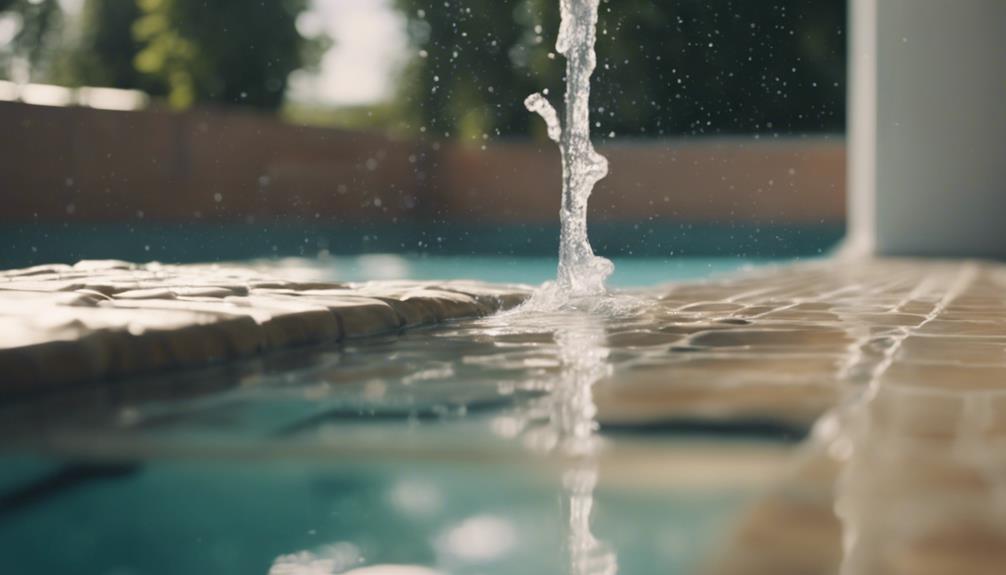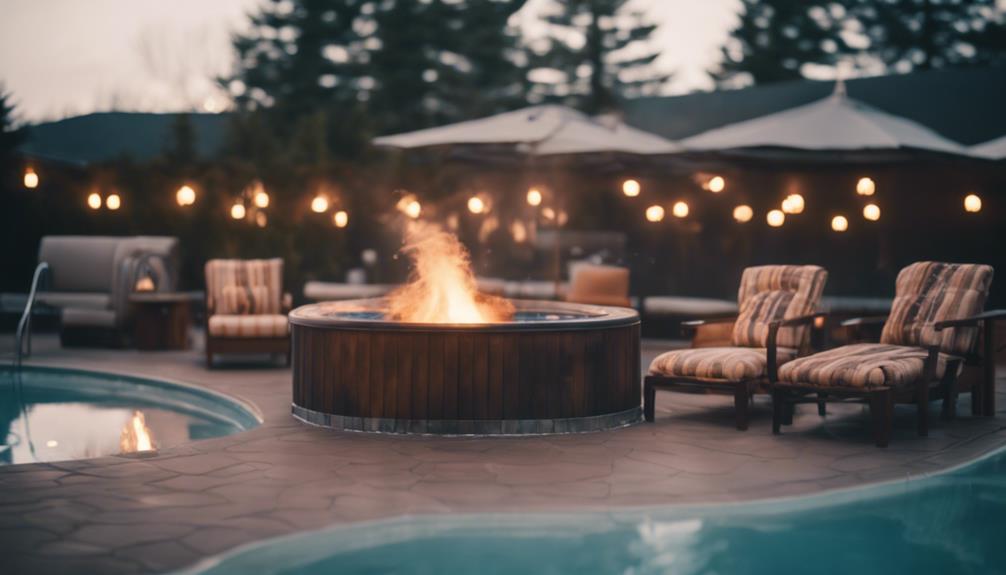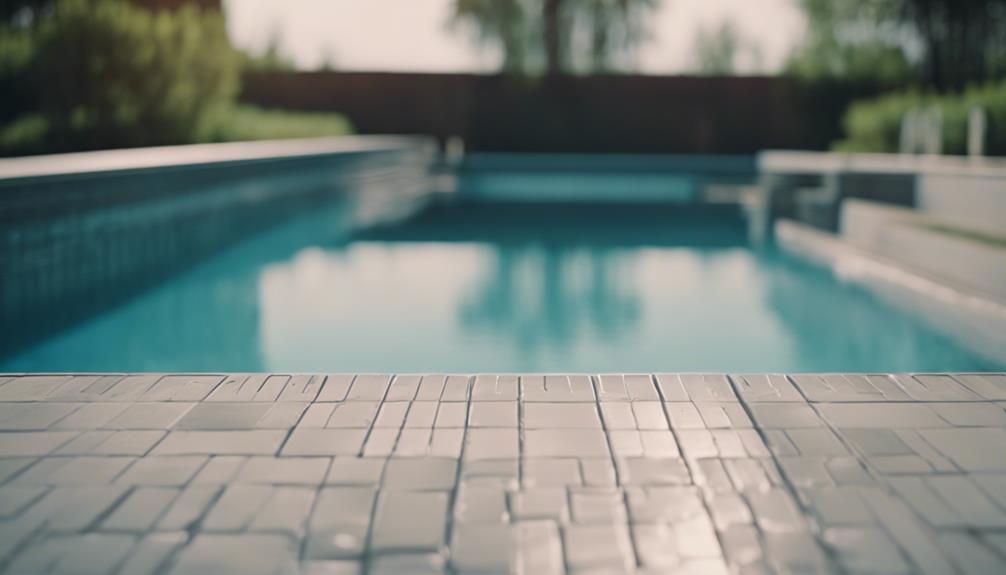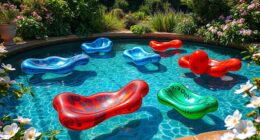Swimming pools can lose water due to excessive splashing from lively activities or disruptive behavior. Evaporation is an important factor influenced by temperature and humidity; using covers or solar blankets can help reduce it. A chemical imbalance can weaken the pool's structure, causing leaks, so maintaining correct levels is necessary. Different pool materials have vulnerabilities, such as cracks in fiberglass or tears in vinyl. Adequate maintenance is vital for aging pools to prevent wear and tear that can lead to water loss. Understanding these factors can help you identify and address the issue effectively.
Key Takeaways
- Excessive splashing from energetic pool activities and disruptive behavior by pool-goers contributes to water loss.
- Evaporation factors, influenced by temperature and humidity, can significantly impact water levels.
- Chemical imbalance weakens pool structures and causes leaks; regular testing and adjustment are crucial.
- Pool material concerns like cracks in fiberglass pools or tears in vinyl pools can lead to water loss.
- Aging pools require regular maintenance to prevent wear and tear, water loss, and ensure structural integrity.
Excessive Splashing
Excessive splashing in swimming pools is a common cause of water loss, often resulting from energetic pool activities and disruptive behavior by pool-goers. Activities like cannonballs and vigorous splashing can lead to a significant decrease in water levels.
To confirm excessive splashing as the cause of water loss, pool owners can conduct a simple test by measuring water levels before and after a period of no splashing.
Educating pool users on the impact of excessive splashing and implementing rules to minimize disruptive behavior can help prevent unnecessary water loss.
Regular monitoring of water levels is essential to promptly detect and address any significant drops caused by excessive splashing, ensuring the efficient use and conservation of pool water.
Evaporation Factors
Evaluating the environmental elements that contribute to water loss in swimming pools is crucial for effective water conservation and maintenance. Understanding evaporation factors such as water temperature, air temperature, wind speed, and humidity is key in this process.
By conducting a simple bucket test to compare evaporation rates between the pool and a nearby bucket, pool owners can accurately assess the impact of environmental factors.
To mitigate water loss due to evaporation, using solar blankets or safety covers can be beneficial in reducing evaporation rates. Managing pool water levels efficiently based on an understanding of evaporation factors is essential for maintaining ideal water levels and conserving water resources.
Chemical Imbalance Impact

Maintaining proper chemical balance in swimming pools is essential for ensuring structural integrity and cleanliness. Imbalanced pool chemicals can weaken pool structures and result in leaks, contributing to water loss. To address this issue, it is important to seek professional help from maintenance workers to maintain the correct chemical balance.
Regularly testing pool water for chemical levels and adjusting them as needed is essential in preventing structural damage and water loss. Ensuring that pool chemicals are properly balanced not only maintains the pool's structural integrity but also promotes a clean and safe swimming environment.
Pool Material Concerns
Concerns regarding pool materials include specific vulnerabilities to wear and tear based on the type of material used in pool construction.
Fiberglass pools are susceptible to cracks, especially when the surrounding sand is saturated, leading to water loss.
Vinyl pools are prone to tears caused by sharp objects, necessitating immediate repairs to prevent leaks.
Concrete pools, on the other hand, should be inspected every 5-10 years for hairline cracks due to aging and potential damage from sharp objects.
Regularly checking pool materials for signs of wear and addressing any issues promptly is essential in preventing water loss.
Aging Pools Maintenance

Regular maintenance is vital for preserving aging pools and preventing water loss. As pools age, they become more prone to wear and tear, leading to potential leaks and water loss. To effectively maintain aging pools, regular inspections are necessary to identify and address any issues promptly.
Inspect pool materials such as fiberglass, vinyl, or concrete for cracks, tears, or other signs of deterioration. Addressing these maintenance concerns promptly can help prevent water loss and prolong the lifespan of the pool.
Additionally, maintaining proper chemical balance and minimizing excessive splashing can further prevent water loss in aging pools. By implementing a proactive maintenance routine, pool owners can guarantee that their aging pools remain in good condition and minimize water loss.
Frequently Asked Questions
Can Landscaping Around My Pool Cause Water Loss?
Landscaping around a pool can contribute to water loss through factors like excessive foliage absorbing water, soil erosion affecting pool stability, and plants damaging pool structures. Proper landscaping design and maintenance are essential to prevent water loss.
Is a Leaking Pool Covered by Homeowner's Insurance?
While a leaking pool may be covered by homeowner's insurance in certain cases, it typically depends on the cause of the leak. Consult your insurance provider to understand coverage details and potential reimbursement options.
How Can I Prevent Animals From Causing Pool Leaks?
To prevent animals from causing pool leaks, install barriers like fences or covers to deter entry. Regularly inspect the pool area for signs of animal activity. Address any potential entry points promptly to safeguard against damage and water loss.
Can High Water Pressure Lead to Pool Water Loss?
High water pressure in a swimming pool can potentially lead to water loss by causing leaks in the pool's structure, particularly if the pressure exceeds the pool's design limits. Regular monitoring and maintenance can help prevent such issues.
Are There DIY Methods to Detect Pool Leaks?
Discovering pool leaks can be challenging. DIY methods include conducting a bucket test, using food coloring to trace leaks, and inspecting pool materials for damage. Seeking professional assistance guarantees accurate leak detection and timely repairs.
Conclusion
To sum up, grasping the factors contributing to water loss in swimming pools is essential for maintaining their integrity and functionality.
One interesting statistic to note is that a typical residential pool can lose up to 1/4 inch of water per day due to evaporation alone.
By identifying and addressing the root causes of water loss, pool owners can guarantee the efficient use of water resources and prolong the lifespan of their pools.










